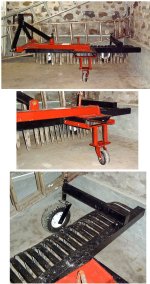Peter, I did use an acetelene cutting torch to cut out the hole for the receiver tube. However, there are numberous ways to accomplish what I did but with simpler tools. One approach would be to weld a 3/4" X 2" bar of steel 4 or 5 inches long directly to the box. Simpler yet would be to weld the same to a 3"x3" plate and bolt it to the box. Or, for that matter, weld a 2" receiver tube to the plate and bolt it to the box. That way you could have it welded elsewhere. I went for maximum flexibility and fortunately I had enough equipment to do it. Other than the gas and MIG welder, I used an electric band saw (metal cutting) and a drill press to drill the 9/16" holes for the pin. I'm not very good with the cutting torch and just ok with the welder, but I have fun!
On another subject you brought up, I've given a lot of thought to adding training wheels to some of my implements too. Specifically, I want to buy a back blade and add adjuster wheels. However, my thoughts on this is to minimize the variance caused by the tractor going over rough terrain. I want this blade for leveling ground. I'm thinking that I would like to have the blade maybe 4 feet behind the tractor with the wheels directly behind that. My rationale is that the leverage from the hitch to the blade relative to the blade to the wheels would reduce the up down movement significantly. I've searched for such a blade but haven't found one other than for ATVs which are too small. Assuming that works, then I want the same setup with a rake. Does anyone have any experience with such a setup?
Problem is, I'm beginning to think I'll never get my land done cuz I'll always be making tractor implements!
Larry...
On another subject you brought up, I've given a lot of thought to adding training wheels to some of my implements too. Specifically, I want to buy a back blade and add adjuster wheels. However, my thoughts on this is to minimize the variance caused by the tractor going over rough terrain. I want this blade for leveling ground. I'm thinking that I would like to have the blade maybe 4 feet behind the tractor with the wheels directly behind that. My rationale is that the leverage from the hitch to the blade relative to the blade to the wheels would reduce the up down movement significantly. I've searched for such a blade but haven't found one other than for ATVs which are too small. Assuming that works, then I want the same setup with a rake. Does anyone have any experience with such a setup?
Problem is, I'm beginning to think I'll never get my land done cuz I'll always be making tractor implements!
Larry...

